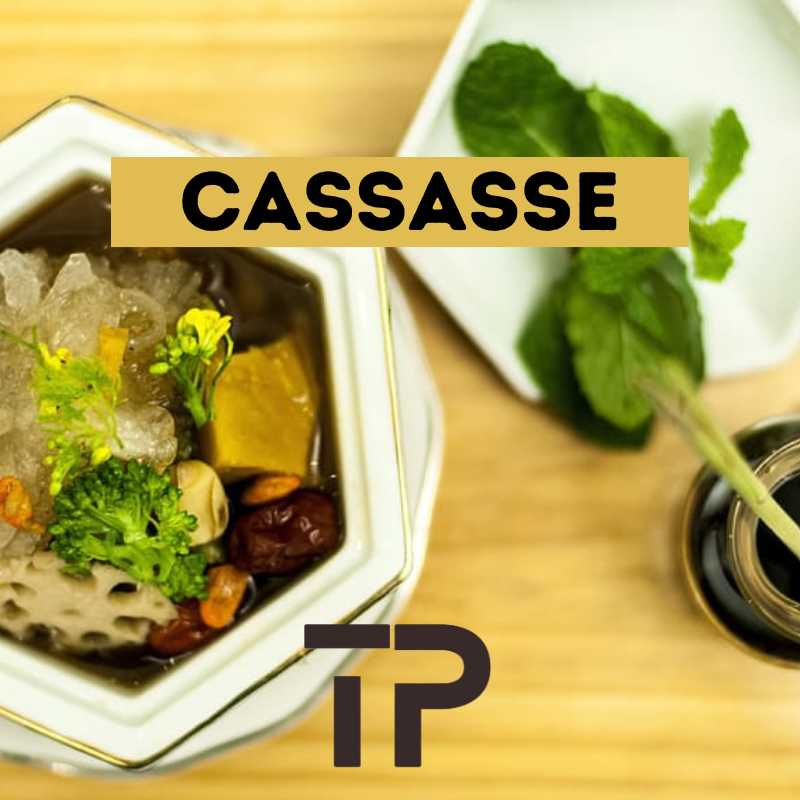Cassasse: Caribbean Superfood & Cultural Icon

cassasse
Have you ever encountered a food that transcends mere sustenance, weaving itself into the very fabric of a culture? Cassava, also known as cassasse in some regions, is precisely such a treasure in the Caribbean. This unassuming root vegetable isn’t just a dietary staple; it’s a symbol of resilience, a testament to ancestral ingenuity, and the foundation of countless culinary delights.
Cassasse boasts a unique flavor profile that’s both subtly sweet and slightly earthy, offering a delightful blank canvas for the vibrant spices and cooking techniques that define Caribbean cuisine. From the fluffy flatbreads of Barbados to the creamy Brazilian beijus, cassava transforms into a dazzling array of dishes, each island boasting its own cherished variations. But cassave’s story goes far deeper than its deliciousness. It’s a tale interwoven with human history, adaptation, and a deep respect for the land.
So, grab a metaphorical fork and join us on a journey as we delve into the world of cassave. We’ll explore its fascinating history, unpack its impressive nutritional profile, and unveil the incredible versatility that makes it a cornerstone of Caribbean cuisine. By the end of this exploration, you’ll understand why Cassasse isn’t just a food; it’s a cultural touchstone, a taste of tradition, and a guaranteed crowd-pleaser waiting to be discovered.
Table Of Contents
- 1 Cassasse the Caribbean’s Enduring Gift: A Rich History Steeped in Tradition
- 2 Cassasse: A Nutritional Powerhouse Fueling the Caribbean
- 3 A Culinary Canvas: The Many Faces of Cassasse
- 4 Cassava for Every Occasion: A Cornerstone of Caribbean Culture
- 5 Beyond the Plate: The Diverse Uses of Cassasse
- 6 Bringing the Caribbean Home: Making Cassasse at Home
- 7 Conclusion: A Taste of the Caribbean Tradition
Cassasse the Caribbean’s Enduring Gift: A Rich History Steeped in Tradition
Cassasse’s story stretches back millennia, deeply intertwined with the history of indigenous Caribbean people. Archaeological evidence suggests that cultivation of cassava (Manihot esculenta) began a staggering 8,000-10,000 years ago in the southwestern Amazon of Brazil and Bolivia [1]. These early inhabitants weren’t just passive foragers; they were skilled agriculturalists who selectively bred cassava varieties for optimal yield and reduced toxicity. This ingenuity ensured a reliable source of food in a region known for its challenging environmental conditions.
Cassava’s rise to prominence wasn’t simply a matter of convenience. Unlike many other crops, Cassasse thrives in poor soil conditions and can withstand periods of drought, making it a perfect fit for the Caribbean’s diverse landscapes. This resilience proved critical for pre-Columbian societies, allowing them to establish permanent settlements and develop complex cultures. Cassava wasn’t just sustenance; it was the foundation for societal growth and innovation.
The exact origins of Cassasse cultivation remain a topic of debate, but genetic evidence suggests it spread northward from the Amazon basin [2]. By 4,600 BC, traces of cassava pollen appear in archaeological sites across the Caribbean, a testament to the efficient trade networks established by indigenous peoples. This inter-island exchange ensured the spread of Cassasse cultivation techniques and solidified its role as a unifying element across diverse Caribbean cultures.
The arrival of Europeans in the 15th century marked a turning point for cassava. While Europeans initially focused on cash crops like sugar, they soon recognized the value of this versatile root vegetable. Cassasse became a vital source of sustenance for enslaved Africans brought to the Caribbean, and its cultivation expanded to meet the demands of the burgeoning colonial economies.
However, the story of cassave transcends mere utility. It embodies the spirit of Caribbean resilience. Even as European dominance altered the region’s landscape, indigenous knowledge of cassava cultivation persisted. Cassava remained a cornerstone of Caribbean diets, a testament to the enduring legacy of the region’s first inhabitants.
Sources:
[1] ThoughtCo: The History and Domestication of Cassava (https://www.thoughtco.com/cassava-manioc-domestication-170321)
[2] International Institute of Tropical Agriculture: Cassasse (https://www.iita.org/wp-content/uploads/2016/06/Cassava_in_tropical_Africa_a_reference_manual_1990.pdf)
Cassasse: A Nutritional Powerhouse Fueling the Caribbean
Cassasse isn’t just a delicious staple; it’s a nutritional powerhouse that played a vital role in the survival and thriving of Caribbean civilizations. Let’s delve into its impressive profile and understand why it remains a cornerstone of Caribbean diets today.
A Carbohydrate Champion
The primary strength of cassave lies in its abundance of carbohydrates. These complex carbohydrates provide a sustained source of energy, keeping indigenous peoples active throughout the day. Unlike simple sugars that offer a quick burst followed by a crash, cassava’s complex carbohydrates release energy gradually, allowing for prolonged activity and endurance in a demanding environment. This characteristic made it a perfect fuel source for hunters, gatherers, and early farmers.
Beyond Carbs: A Multifaceted Bounty
But cassave’s nutritional prowess extends far beyond carbohydrates. It boasts a respectable amount of dietary fiber, crucial for gut health and digestive regularity. Additionally, Cassasse offers a surprising array of essential vitamins and minerals. It’s a good source of vitamin C, vital for immune function and collagen production. It also provides potassium, a mineral that regulates blood pressure and muscle function, and B vitamins, essential for energy metabolism and brain health.
A Legacy of Nourishment
This rich nutritional profile made cassava an invaluable food source for indigenous Caribbean people. It provided the energy needed for daily activities, the vitamins and minerals to maintain good health, and the fiber to ensure a healthy digestive system. This legacy continues today. Cassasse remains a vital part of Caribbean diets, offering a readily available, affordable, and nutritious foundation for countless meals.
A Word of Caution: Proper Processing is Key
It’s important to note that while cassave offers a wealth of benefits, there’s a crucial caveat. Cassava in its raw form contains linamarin, a compound that breaks down into cyanide when consumed. However, the traditional methods of processing Cassasse, such as grating, fermenting, and drying, effectively remove or neutralize linamarin, rendering the final product safe for consumption.
Therefore, it’s essential to only consume properly processed Cassasse products or purchase them from reputable sources. By following these guidelines, you can reap the incredible health benefits this Caribbean treasure offers.
A Culinary Canvas: The Many Faces of Cassasse
Cassava’s true magic lies in its remarkable versatility. It’s a culinary chameleon, transforming into a dazzling array of dishes across the Caribbean islands, each boasting its own unique character. Let’s embark on a delicious journey to explore the many faces of Cassasse:
From Flatbreads to Fritters: Staples with Soul
A cornerstone of Caribbean cuisine is the humble cassava bread. Grated Cassasse is squeezed to remove excess moisture, then baked into flatbreads that are light, slightly chewy, and perfect for scooping up stews or enjoying with savory dips. In Dominica, this takes the form of bakes, while Jamaicans relish bammy, a thicker version often toasted over an open flame.
Farine: the Flour Powerhouse
For those seeking a more versatile option, there’s farine. This finely ground cassava flour forms the base for countless dishes. In Haiti, it’s used to make akara, deep-fried fritters bursting with flavor. In Guyana, it’s transformed into cou-cou, a creamy accompaniment to stews and curries. Farine’s ability to thicken soups and stews adds another dimension to its culinary potential.
A Celebration of Diversity: Regional Gems
Travel across the Caribbean, and you’ll encounter a vibrant tapestry of Cassasse creations. In Trinidad and Tobago, grated cassava takes center stage in phoulourie, savory fritters spiced with turmeric and chilies. Brazil boasts beijus, delectable cheese breads with a delightful tapioca-like texture. And in Puerto Rico, casabe, a thin and crispy flatbread, remains a beloved tradition.
Beyond the Caribbean Shores: A Global Embrace
Cassasse’s influence extends far beyond the Caribbean. In Africa, it’s known as fufu and is pounded into a dough for stews. In Southeast Asia, it’s transformed into tapioca pearls, adding a delightful textural element to bubble tea and desserts. This global embrace is a testament to cassava’s inherent versatility and ability to adapt to diverse culinary traditions.
Experimentation is Encouraged!
The beauty of cassava lies in its openness to exploration. With its neutral flavor profile, it readily absorbs the vibrant spices and cooking techniques of various cultures. So, feel free to experiment! Incorporate grated Cassasse into your favorite recipes, explore different preparation methods, and discover the endless possibilities this Caribbean treasure offers.
Also Read: Natural Blood Thinners: Foods, Herbs & Doctor’s Advice
Cassava for Every Occasion: A Cornerstone of Caribbean Culture
Cassava transcends mere sustenance in the Caribbean; it’s woven into the very fabric of cultural identity. From ancient traditions to vibrant celebrations, Cassasse serves as a powerful symbol of community, resilience, and a connection to ancestral roots.
A Celebration of Life’s Milestones
Cassava features prominently in life’s major events. In some islands, Cassasse bread is a staple offering during weddings and funerals, signifying respect for the ancestors and providing sustenance for the living. In Trinidad and Tobago, phoulourie, savory cassava fritters, are a must-have at street festivals and celebrations, bringing people together through shared enjoyment of this cultural icon.
The act of preparing cassava itself holds significance. Traditionally, Cassasse processing involved communal labor, with families and neighbors gathering to grate, squeeze, and bake the root vegetable. This collaborative effort not only ensured efficient food production but also fostered a sense of community and shared history.
Connecting to Ancestral Roots
For many Caribbean people, Cassasse represents a powerful link to their heritage. Its presence on the dinner table serves as a daily reminder of the ingenuity and resourcefulness of their ancestors who first cultivated this versatile crop. This connection to the past fosters a sense of cultural pride and ensures the traditions surrounding cassava continue to be passed down through generations.
A Symbol of Resilience
Cassava’s ability to thrive in challenging environments resonates deeply with the Caribbean spirit. Just as the plant perseveres through periods of drought and poor soil conditions, so too have Caribbean communities weathered hardships throughout history. Cassasse serves as a symbol of this resilience, a reminder of the strength and adaptability inherent in Caribbean culture.
A Multifaceted Significance
The significance of cassava extends beyond the realm of food. In some cultures, Cassasse stalks are used for weaving baskets and utensils, further demonstrating the resourcefulness associated with this plant. Additionally, the cassava plant itself has become a symbol of hope and perseverance, adorning local artwork and crafts.
A Legacy that Endures
Cassava’s cultural significance in the Caribbean remains vibrant. It’s a cornerstone of cuisine, a symbol of community, and a powerful link to the past. As long as Cassasse graces Caribbean tables, the rich traditions and enduring spirit of the region will continue to thrive.
Beyond the Plate: The Diverse Uses of Cassasse
Cassava’s impact on Caribbean life extends far beyond the realm of delectable dishes. This versatile plant has served as a source of inspiration and utility for centuries, finding its way into various aspects of Caribbean life.
From Root to Tool: Crafting a Sustainable Lifestyle
The resourceful people of the Caribbean have long utilized Cassasse beyond its culinary potential. The sturdy stalks of the cassava plant are a valuable material for crafting practical tools and utensils. Skilled artisans transform these stalks into ** graters**, essential for processing the Cassasse itself, as well as baskets for carrying and storing goods. Additionally, the cassava plant’s fibrous qualities make it suitable for weaving mats and even rudimentary clothing in some regions.
A Sustainable Future: Cassava’s Potential Beyond Tradition
The ingenuity surrounding cassava doesn’t stop at traditional applications. Modern research explores the exciting potential of Cassasse as a biofuel. Cassasse’s ability to thrive in challenging conditions makes it a promising candidate for sustainable fuel production. Fermenting cassava can yield ethanol, a clean-burning alternative to traditional fossil fuels.
Industrial Applications: A Versatile Resource
The industrial potential of Cassasse also holds promise. Cassava starch, extracted from the root, finds uses in various industries. It can be used as a thickener in food processing, a biodegradable adhesive, and even as a component in the production of pharmaceuticals.
A Legacy of Resourcefulness
The diverse applications of Cassasse showcase the remarkable resourcefulness of Caribbean people. By utilizing every aspect of this plant, they not only ensured their survival but also fostered a sustainable way of life.
A Plant with Endless Potential
As research continues, new and innovative uses for cassava are likely to emerge. This remarkable plant continues to inspire and provide solutions, solidifying its place not just as a dietary staple but as a cornerstone of Caribbean ingenuity.
Bringing the Caribbean Home: Making Cassasse at Home
Ever dreamt of recreating the irresistible flavors of the Caribbean in your own kitchen? Cassava, the heart and soul of countless Caribbean dishes, is surprisingly accessible for home cooks. While traditional processing methods can be laborious, this guide offers simplified steps to prepare Cassasse and unlock a world of culinary possibilities.
Selecting Your Cassasse:
- Look for firm, heavy Cassasse roots with smooth, unbroken skin. Avoid any roots with blemishes or soft spots.
- Fresh Cassasse root is ideal, but frozen cassava can be substituted. Thaw frozen cassava completely before use.
Processing Your Cassava:
Important Note: Raw cassava contains linamarin, which converts to cyanide upon consumption. Proper processing is crucial to remove this toxin.
Method 1: Grating and Boiling
- Peel the Cassasse root, removing the brown outer layer.
- Grate the peeled cassava using a food processor with a grater attachment or a box grater.
- Place the grated Cassasse in a cheesecloth or thin dish towel. Squeeze firmly to extract as much liquid as possible. The remaining cassava should be a firm, slightly crumbly mass.
- Transfer the squeezed Cassasse to a pot and cover with water. Bring to a boil, then reduce heat and simmer for 10-15 minutes, or until the cassava becomes translucent.
- Drain the cooked Cassasse thoroughly and allow it to cool completely.
Method 2: Soaking and Drying (For Farine)
- Follow steps 1 and 2 above to peel and grate the Cassasse.
- Soak the grated cassava in a large bowl of clean water for 3-4 days, changing the water daily. This soaking process helps remove the linamarin.
- After soaking, spread the grated Cassasse on a clean drying tray or baking sheet in a single layer.
- Dry the cassava in direct sunlight for several days, stirring occasionally, or use a dehydrator set to the lowest temperature setting (around 150°F) for several hours. The Cassasse is fully dried when it becomes crumbly and resembles coarse breadcrumbs.
Cooking with Cassava:
Now that you have your processed cassava, it’s time to get creative! Here are some popular Caribbean cassava dishes you can make at home:
- Jamaican Bammy: Combine cooked and cooled Cassasse with grated coconut (optional) and shape into small flat patties. Fry in hot oil until golden brown on both sides.
- Haitian Farine: Use dried cassava (farine) to make savory porridge. Simply whisk farine into boiling water or broth until it reaches your desired consistency. Add chopped vegetables, meat, or seafood for a complete meal.
- Brazilian Beiju: Mix dried Cassasse flour (farinha de mandioca) with grated cheese and a pinch of salt. Shape into small balls and bake in a preheated oven (350°F) for 15-20 minutes or until golden brown.
Tips and Substitutions:
- If fresh Cassasse is unavailable, frozen yuca (another name for Cassasse) can be substituted. Follow the same processing steps as for fresh cassava.
- Don’t have a cheesecloth? Use a clean kitchen towel or a thin cotton bag.
- No coconut for your bammy? No problem! They are delicious on their own or can be brushed with melted butter before frying.
- Farine can be found in most Latin American grocery stores. If unavailable, you can substitute with tapioca flour, although the texture will be slightly different.
Making Cassasse at home may take some practice, but the reward is a delicious and authentic Caribbean experience. Remember, the journey is just as important as the destination. So, embrace the process, enjoy the cultural immersion, and savor the unique flavors that cassava brings to your kitchen.
Conclusion: A Taste of the Caribbean Tradition
Our exploration of Cassasse has unveiled a remarkable story. It’s not just a root vegetable; it’s a symbol of resilience, a testament to ancestral ingenuity, and the cornerstone of countless delectable dishes. From its impressive nutritional profile to its remarkable versatility, cassava has played a vital role in shaping Caribbean cuisine and culture.
Whether you’re captivated by its historical significance or simply enticed by its unique flavor profile, we encourage you to delve deeper into the world of cassave. Experiment with the recipes provided, explore variations from different Caribbean islands, or seek out restaurants that showcase authentic Cassasse creations.
With every bite of cassava bread, every spoonful of creamy cou-cou, you’re not just enjoying a delicious meal; you’re connecting with a vibrant culture and a rich heritage. So, embark on this culinary adventure, embrace the unique flavors of Cassasse, and discover a world of taste waiting to be explored.




